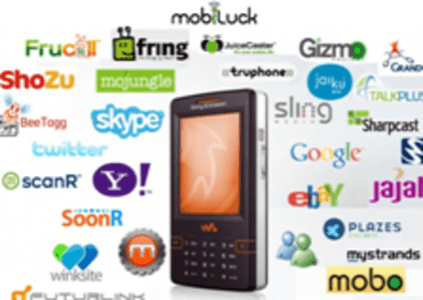Looking back on 2008, we can definitely call it the year of the Mobile Web. That designation, in large part, is due to the success of the iPhone. Although the iPhone was originally launched in 2007, it wasn’t until mid-2008 that the 3G version debuted, bringing with it the faster internet speeds that finally made the device a usable mobile computing platform.

There is no doubt that the iPhone led to a trickle-down effect that influenced nearly every aspect of both handset development and the mobile web itself. Every manufacturer is looking for an “iPhone killer,” everyoneis dong an app store, and websites themselves are becoming iPhone-friendly. Meanwhile, mobile app developers are reaping the rewards of having a new platform on which they can develop.
That being said, we can’t ignore the fact that other phones have made a big impact this year as well. Most notably, we have Android, Google’s new mobile OS, first launched on the T-Mobile G1 and now coming to a very Blackberry-esque device in Australia. Thanks to Android’s open source version, the question of how it will compare to iPhone has a simple answer: Android is open where the iPhone is closed.

This is the fifth in our series of top products of 2008:
- Top 10 Semantic Web Products of 2008
- Top 10 International Products of 2008
- Top 10 Consumer Web Apps of 2008
- Top 10 RSS and Syndication Products of 2008
With the above thoughts in mind, as we look back at the best mobile apps from 2008, we can’t help but notice how iPhone apps top the list. Still, we’ve tried to include apps here that aren’t iPhone-only so that we can deliver a truly well-rounded list. If we missed your favorite app (and surely we did – these lists are always subjective), let us know in the comments. Also, please note that we chose not to include games on this list – at this point, that’s a whole other category.
1. Twitter
Without a doubt, Twitter is one of the best social networks to use on your mobile device. You can update your status, send replies, and engage in 140-character conversations from the palm of your hand by way of any number of mobile applications or even via SMS (in some countries, that is). However, it’s hard to pick a clear winner in the category of best mobile Twitter application. Depending on your platform, there are multiple apps available and everyone has their own personal favorite.

In an informal poll on Twitter and FriendFeed, we saw some applications received more votes than others. Those included Twitterberry, which is the Twitter app for Blackberry it seems, and Tiny Twitter was popular among Windows Mobile users. For the iPhone, things were more complicated. There are several different applications available, but we noticed that TwitterFon and Tweetie got the most votes. Plus, the newer app Tweetsville is worth mentioning, too, as it has been getting a lot of buzz lately.
Earlier this year, we had polled the blogosphere on the same subject and found then that the top mobile app for Twitter was Hahlo. Only a few months later, and so much has changed. It seems that as new Twitter apps are released, mobile Twitter users rush to try them and often end up with a new favorite du jour. What ends up being your favorite app in the long run has a lot to do with personal preference as well as how you user Twitter. Power users may find the apps with more features to be the best, while casual users might prefer a more simplified interface. In the end, what’s most telling about this trend to tweet from our mobiles is that it’s not about one particular application. Instead, what’s important is that nearly everyone is tweeting. That makes Twitter itself the mobile winner, no matter which application you use to interact with it.
Read some of our top Twitter articles from this past year:
How We Use Twitter for Journalism
The Rise of Twitter as a Platform for Serious Discourse
How To Get Customer Service Via Twitter
2. FFtoGo
Let’s face it, we’re social media addicts, and this year, no other social network has been discussed quite as much as FriendFeed. Initially, there was concern that FriendFeed was relocating the conversations that used to take place on blogs and moving them elsewhere. The conversation has left the blogosphere, we cried. Not only that, but FriendFeed’s stream of updates began to overwhelm even the best of us. It just became so noisy that the service began to lose its original luster after a while. But then things started to change. FriendFeed implemented dupe detection and bloggers (like us!) found ways to integrate it with their commenting mechanisms. When FriendFeed implemented lists in late August, we were sold. FriendFeed finally became more manageable and thus, more fun.

Of course, we didn’t want to give up FriendFeed just because we were going to be away from our computers. That’s where the mobile application FriendFeedToGo came in. Thanks to developer Benjamin Golub, we were given FFtoGo.com, a mobile interface for FriendFeed that soon became the interface of choice, even over the company’s own iPhone version. Needless to say, those at FriendFeed knew a good thing when they saw one and soon swooped up Benjamin to join the rest of the FriendFeeders in downtown Mountain View, California. We couldn’t have been more pleased.
3. Google Maps
What’s one of the most important applications you need on a mobile phone? Maps! And when it comes down to it, the application of choice is Google Maps. This year, we saw Google launch their own mobile OS, code-named Android, and with it came one of the coolest applications we had yet seen: Google Maps with Street View for Mobile.

In September, Google updated their Google Maps for Mobile application, which brought Street View to non-Android phones including Blackberry and those phones powered by Java. There was only one glaring omission: the iPhone. Thankfully, iPhone owners finally received Street View, too, with the iPhone 2.2. firmware update, released in November. Google also released a mobile app with voice recognition that same month. These developments came much to the relief of iPhone users who had previously worried that Google was going to only release their coolest apps for Android. Thankfully, that wasn’t the case.
Speaking of Google, we should also note that many of you said you couldn’t live without your other Google apps, either. Google Reader and Gmail were also hugely popular apps across all mobile platforms this year.
4. Fring
The popular mobile IM and VOIP service Fring lets you access and interact with your social networks on the go, make free calls, and chat with your friends over IM – what more could you want in a mobile app? The service supports Skype, Windows Live Messenger (MSN Messenger), Google Talk, ICQ, SIP, Twitter, Yahoo!, and AIM, and all are made available over your phone’s internet connection. With the Fring app, you can see who’s online, have multiple conversations at once, and even send and receive files with your friends

Fring also launched an Application Programming Interface (API) earlier this year that offers the Fring mobile interface, IM, presence indication, file transfer and other features to developers seeking to build apps in standard server-side languages. Thanks to the fringAPI, you can access an ever-expanding group of Fring add-ons including ones for Facebook, Gmail Notifier, Vtap Video Streaming, Orkut’s Social Network, Yandex Push Email, and more.
Fring has long been a favorite app for iPhone – it was one of the top apps for jailbroken phones prior to the launch of the iPhone SDK. Strangely, though, there was a long delay between the July 11th opening of the iPhone app store and the October 2008 launch of the official Fring iPhone app.
It’s also worth noting that Fring isn’t an iPhone-only application – it’s supported on a large number of handsets from many different carriers. To see if yours is supported go to m.fring.com.
5. Brightkite
Yes, the mobile social network Brightkite includes an iPhone app, but it’s much more than a toy for the exclusive club of iPhone owners. The service, a device agnostic, SMS-based application, lets you “check in” at various locations out in the real world and then see who else is there, has been there, and who is nearby. You can check in via text, web,or iPhone, but text is easiest if you’re using a traditional cell phone.

After checking in, you can post updates in a Twitter-like fashion and upload photos to your Brightkite-enabled stream, available at a URL in the format of brightkite.com/people/username. The newly launched “Wall” feature makes Brightkite ideal for conferences and live events as it allows anyone to display the live stream of notes, photos, and checkins at any one place in a large, full screen view that can be shown on any monitor, projector, or TV.
Brightkite isn’t on this list because it’s hugely successful in terms of numbers – it’s here because of its potential. There’s still some debate as to whether consumers really want new and separate social networks just for the mobile phone. As we noted back in October, no other social network, including those specialized for mobile devices, had even reached 15% adoption. That means Brightkite and others like it still have a way to go before they become a solid part of the new mobile web. However, if any of these apps have a chance for success, it’s Brightkite. With the service’s Twitter integration and live event niche, they offer something unique.
Brightkite’s best competition comes from a similar app called Loopt, also a cross-platform tool. Loopt is popular with iPhone users – it made the list of top iPhone apps this year. We think Loopt’s Android version is interesting, too, because it works in the background automatically checking you in as you travel from place to place. However, although Loopt is available on numerous phones and carriers in the U.S., Brightkite works on all phones. Also, whether people want an app with more automated tracking (like Loopt) or more control (like Brightkite) is yet to be seen.
As with any new application, Brightkite is still waiting to achieve critical mass. It’s not mainstream yet, but it’s definitely worth watching in 2009.
6. Pandora
There are a number of apps for streaming radio from your phone, but Pandora is definitely one of the best. The app is based on the Music Genome Project, an effort to categorize and analyze the details about each song in existence – including its melody, harmony, instrumentation, rhythm, vocals, lyrics, etc. – in order to help you find more songs that are like the music you like. To do this, you just listen to some music using Pandora and rate your preferences. Pandora then suggests more songs you might enjoy. If you have diverse tastes, you can even create different Pandora channels – like one for upbeat hip-hop songs and one for your love of classical piano, for example.

Pandora’s mobile application works on a number of different handsets from both Sprint and AT&T, including, of course, the iPhone.
7. Shazam
We have to give a shout-out to one other music-based application in addition to Pandora: Shazam. This clever mobile application helps you identify the song you’re hearing by having you hold up the phone to the source of the music, most often the radio. The app then “listens” to the song and identifies it for you. Shazam is available both on iPhone and Android, as well as other handsets if you happen to live in the UK.

You may be surprised to learn that Shazam wasn’t the first application that could identify songs from your phone. Gracenote’s MusicID technology has been around for ages, but it didn’t have the easy-to-use UI of the Shazam iPhone application. That simplicity combined with the popularity of the iPhone in general, makes Shazam an app worthy of a download…and worthy of its own iPhone commercial, too, it seems.
8. Opera Mini/Mobile
The popular mobile browser from Opera is always one to watch. Having launched a software developers kit (SDK) for widgets this year, there’s a chance for this mobile browser to take on the powerhouse that is the iPhone through its freely developed and distributed widgets that run within the company’s mobile browser on any number of handsets.

The company is already far ahead of rival Mozilla Firefox, whose mobile browser code-named Fennec is still under development. Meanwhile, Opera’s mobile browser is already being shipped on millions of handsets from major mobile manufacturers including HTC, Motorola, Nokia, Samsung, Sony Ericsson, T-Mobile, and more. The browser is also available for different types of mobile operating systems like Symbian, Windows Mobile, Blackberry, and Linux, making it the alternative browser of choice for many handset owners.
There are actually two mobile version of Opera – Opera Mobile for smartphones and Opera Mini for everything else. It’s great that even low-end phones, which are all some folks can afford, can now include a better browser thanks to Opera Mini. Meanwhile, with Opera Mobile’s features like offline browsing, built-in productivity tools, tabbed browsing, and the above-mentioned widgets, the next-gen mobile web experience is available to a wide range of devices.
However, one place you won’t see Opera anytime soon is the iPhone. Although there was some buzz about an Opera iPhone app, if one even exists, it does so in violation of the SDK and would never get app store approval. Widgets would also make it somewhat of a competitor to the App Store itself, and that usually means a reject notice, if history tells us anything. If you ever see Opera on the iPhone, it will most likely be a jailbroken phone. We would still like to see that!
Read More Opera Coverage:
Opera Mobile News (mobile browser for smartphones): Opera Mobile 9.5 Unveiled
Opera Mini News (Opera mobile browser): coverage of both the Opera 4.1 and 4.2 releases
9. NYTimes iPhone App
For mobile news on the go, we’re big fans of what the New York Times has done with their iPhone application. This is a great example of what the newspapers of tomorrow can and should look like, if you ask us. You can view the most popular stories of the day or flip through the various sections of the paper with a flip of your finger. Articles are accompanied by full-color photos, too.

Although there are other mobile news applications out there, we’ve been excited all year about the initiatives that the Times is taking in attempt to stay relevant in today’s digital age. For example, in October, the company launched their first API, making them a news broker just as much as they are a newspaper. More recently, they opened up their front page to outside content, an effort that helps blur the lines between news and blogs even further. We think that NY Times sets a great example for other old media companies trying to embrace the internet age…we only hope that it’s not too late.
Disclosure: RWW is syndicated by the New York Times.
10. i.TV
The i.TV iPhone/iPod Touch application, lets you view the latest TV and movie schedules from your area right on your mobile device. You can also rate shows, leave reviews, and recommend shows to others. The app was ranked as one of the top apps in the iTunes App Store 2008 list, too, coming in a #3 on the list of free entertainment applications.

i.TV just keeps improving, too. Last month, they added Netflix to the app, which lets you search the Netflix database, manage your queue, and add movies and shows to your instant watch queue for instant streaming on your Windows PC, Xbox 360, Roku box, TiVo® Series3, TiVo HD, or TiVo HD XL digital video recorders and select Blu-Ray players. They also integrated with Wikipedia in order to link to articles about shows, movies, and actors within i.TV. Best of all, it’s free.
This app is one of the only ones we listed that’s iPhone/iPod Touch-only, but it was worth including because of its simple, straightforward nature and the useful service it provides. i.TV appeals to everyone – even mainstream users, which is probably what makes it so popular. We agree it deserves the success it has received. i.TV has rapidly become one of our most-used apps this year, even worthy of placement on our iPhone’s homescreen.
What do you think?
It was certainly hard to narrow down all the mobile web products to just ten, but we hope we provided you with a list of apps that were especially noteworthy this past year. (You can see more of our favorite apps here.) If you think your favorite apps were slighted, please share in the comments. Also, remember we didn’t even touch on mobile gaming apps – that’s really a different category at this point – but feel free to share those, too.









